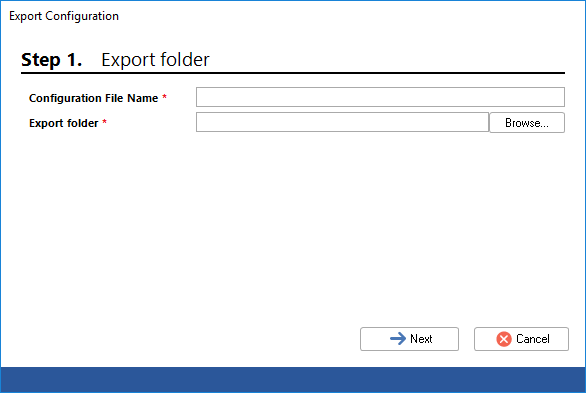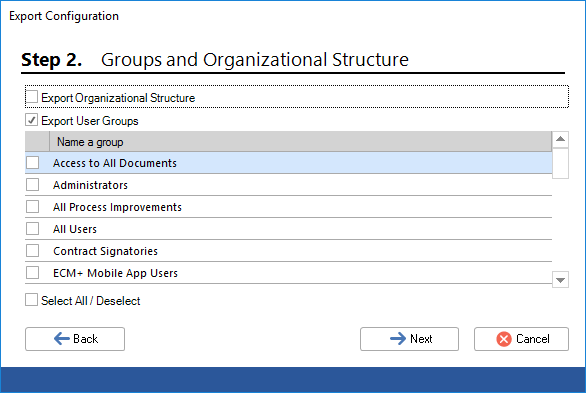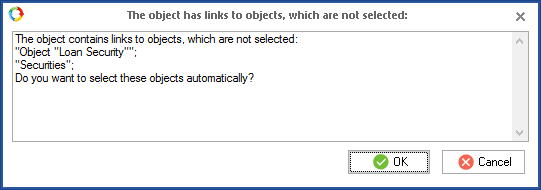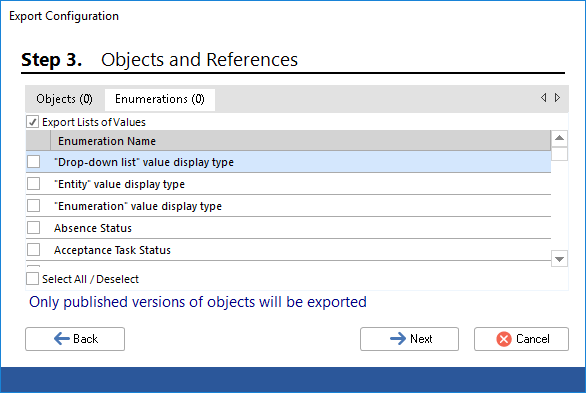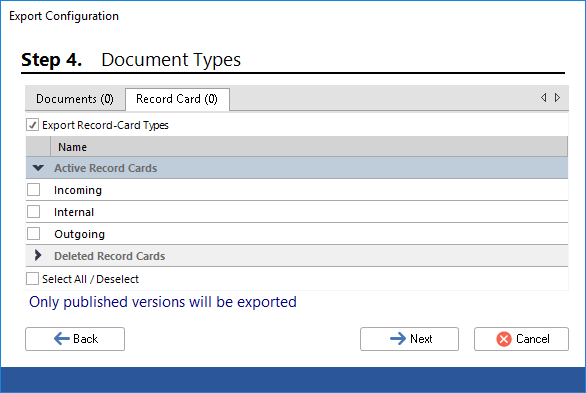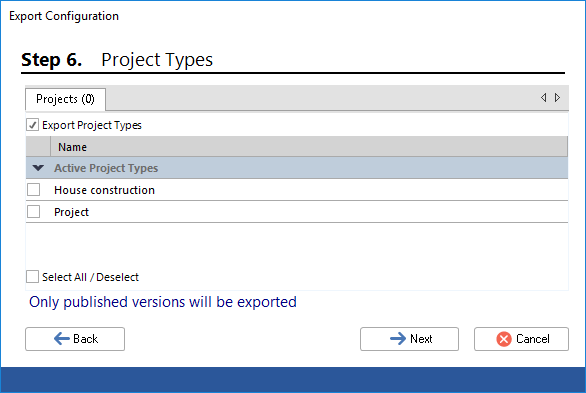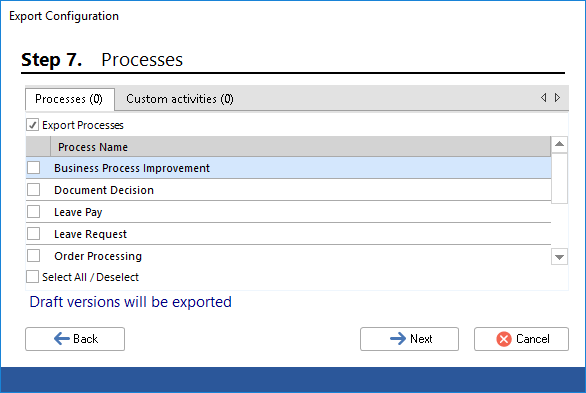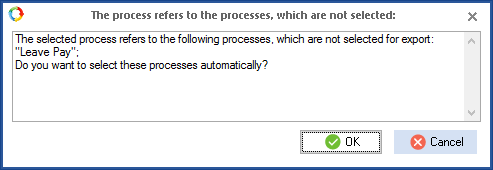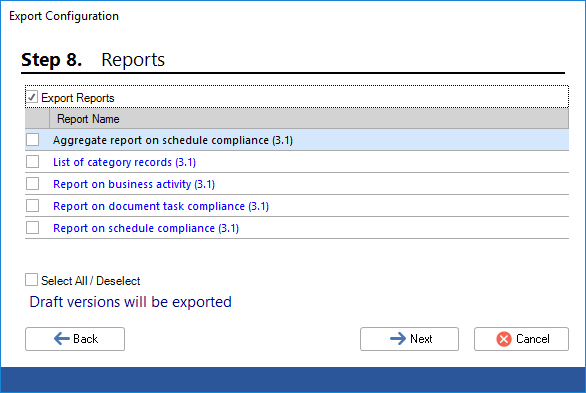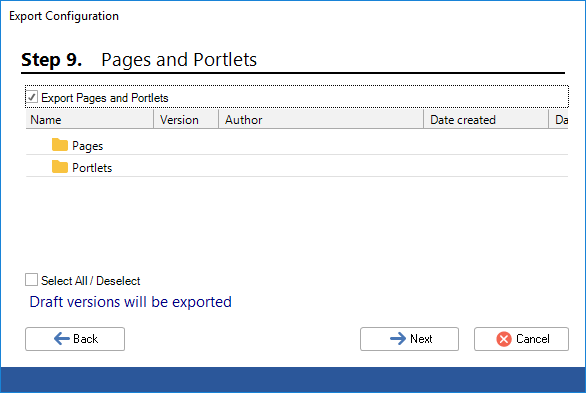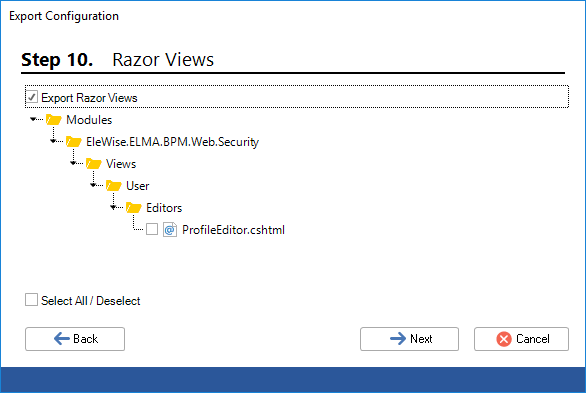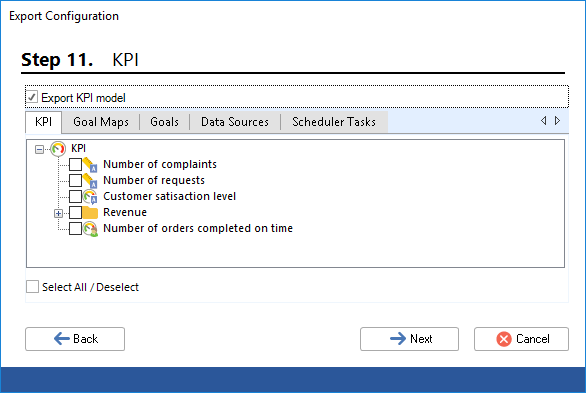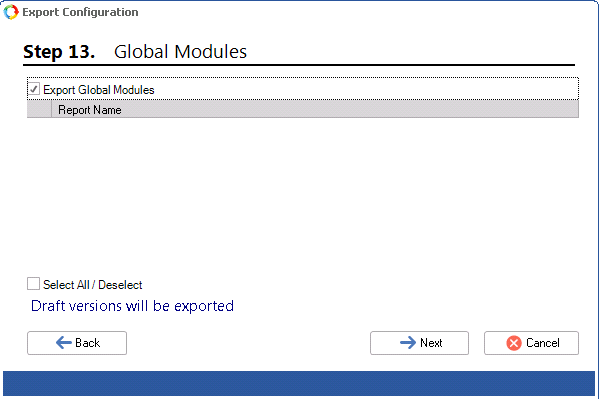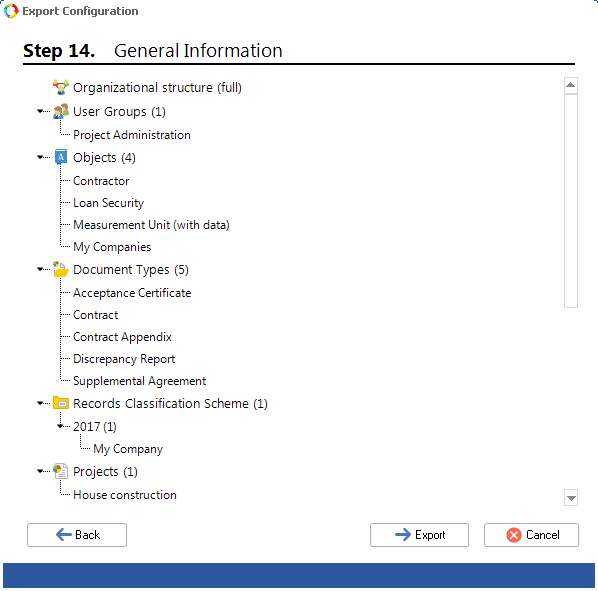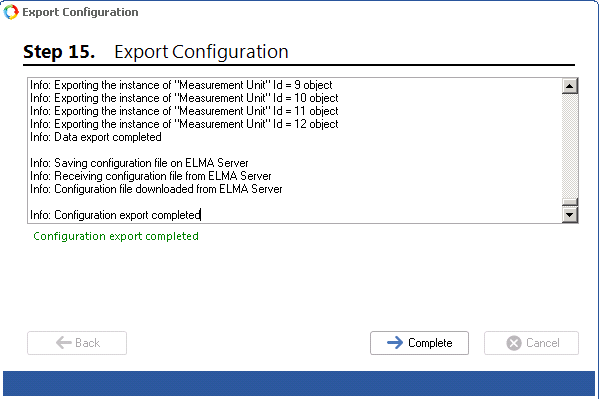Exporting a Configuration
The number and sequence of steps required to export an ELMA configuration depend on the
activated applications.
Use the

and

buttons to go from one step to another. To cancel export, click

.
To initiate configuration export, go to the
main menu of ELMA Designer, the
Configurations section and click
Export Configuration.
Step 1. Export Folder.
In the provided window (Fig. 1), enter the name of the configuration file and click the Browse... button to select the folder where the exported configuration will be stored. Click Next to continue.
Fig. 1. Dialogue box for selecting export folder
Step 2. Groups and Organizational Structure.
Fig. 2. Dialogue box for selecting elements of the organizational structure
-
Export Organizational Structure – when this box is checked, the currently published
organizational model is exported.
-
Export User Groups – when this box is checked, you will see user groups available for export. This box is checked by default. When you deselect it, the user groups are hidden.
-
Select All / Deselect – when this box is checked, all the user groups available for export are selected automatically.
Click Next to continue.
Step 3. Objects and Entities.
At this step, select
objects and
enumerations, which you want to export. Remember, that the last published versions of the selected objects will be published.
There are two tabs in this dialogue box (Fig. 3): Objects and Enumerations. In the parentheses, you can see the number of selected items.
Fig. 3. Dialogue box for selecting objects and enumerations. Objects tab
Note, that if there are linked objects in the system (referencing one another) and you select only one of them, the system will show a notification (Fig. 4) that you should export other linked objects. Unless all the linked objects are exported, it may cause conflicts during the
configuration import.
Fig. 4. Linked object notification
Objects tab
On this tab (Fig. 3), select the objects and data for exporting.
Export objects – when this box is checked, the dialog box displays the list of objects, available for exporting. By default, the box is checked. When the box is unchecked, the list is hidden.
Select All / Deselect – when you check this box, all the available objects become selected.
Export All with Data – when you check this box, all the available data will be selected and the Select All / Deselect box will be checked.
You can export not only the object structure, but also the information on the object instances in the system. To do so, check the Export Data box of the required object.
Enumerations tab
On this tab (Fig. 5), you can select enumerations to export.
Fig. 5. Dialog box for selecting objects. Enumerations tab
Export Lists of Values – when you check this box, the dialog box displays the list of available
enumerations. By default, this box is checked. When you uncheck the box, the list of enumerations is hidden.
Select All / Deselect – when you check this box, all the available enumerations become selected.
Click Next to continue.
Step 4. Document Types.
This step is only available if you have the ELMA ECM+ application activated.
At this step, you can select
document types and
record cards to export. Note, that the last published versions of the selected document types and record cards will be exported.
The documents are shown as two drop-down lists. In the list of Active document types you can see all the valid document types, the deleted document types are shown in the list of Deleted document types. Record cards and projects are grouped in a similar manner.
This dialog box (fig. 6) includes two tabs: Documents and Record Cards. Next to the tab name you can see a number in parentheses, which shows how many objects will be exported.
|
|
|
Fig. 6. Dialog box for selecting document types and record cards. Documents tab
|
Note, that if there are linked objects in the system (referencing one another) and you select only one of them, the system will show a notification (Fig. 7) that you should export other linked objects. Unless all the linked objects are exported, it may cause conflicts during the configuration
import.
Fig. 7. Linked object notification
Documents Tab
Export Document Types – when you check this box, the dialog box displays the list of available
document types. By default, this box is checked. When you uncheck the box, the list of document types is hidden.
Select All / Deselect – when you check this box, all the available document types become selected.
If you check the
Profile box next to a document type, this document type will be exported with all its
settings, configured in ELMA Web Application.
Export all with profiles – check the Profile box for all the document types. Note, that if you check this box, the Select All / Deselect box is checked automatically.
Record Card Tab
On this tab (Fig. 8), you can select
record card types to export.
Fig. 8. Dialog box for selecting document types and record cards. "Record Card" tab
Export Record Card Types – when you check this box, the dialog box displays the list of available
record card types. By default, this box is checked. When you uncheck the box, the list of record card types is hidden.
Select All / Deselect – when you check this box, all the available record card types become selected.
Click Next to continue.
Step 5. Records Classification Scheme.
This step is available only if you have the
ECM+ application activated.
This dialog box consists of several tabs: the tabs' names are the years of your records classification scheme. Next to the tab name (in parentheses) you can see the number of selected objects.
Fig. 9. Dialog box for selecting registration offices
Export Records Classification Scheme – if you select this box, the dialog box will display the list of
registration offices for the year of the selected tab. Registration offices will be exported along with all the nested
sections and
categories.
Select All / Deselect – when you check this box, all the available registration offices become selected.
Unbind from the year – if you check this box, when
importing this configuration, the records classification scheme will be imported to the records classification scheme of the current year or if there is no published scheme, it will be imported to the last published one. If this box is not checked, upon importing the configuration, the records classification scheme will be imported to the scheme for the respective year.
Note, that if there are linked objects in the system (referencing one another) and you select only one of them, the system will show a notification (Fig. 10) that you should export the other linked objects. Unless all the linked objects are exported, it may cause conflicts during the configuration
import.
Fig. 10. Dialog box for selecting registration offices
Step 6. Project Types. This step is available only if the Projects+ application is activated.
At this step (Fig. 11), you can select project types to export. Only the published project types will be exported.
Fig. 11. Dialog box for selecting project types
Click Next to continue.
Step 7. Processes.
At this step, you can select
business processes to export. Only the last saved
version (draft) of the business process will be exported. This dialog box (Fig. 12) includes two tabs: Processes and Custom Activities.
Fig. 12. Dialog box for selecting business processes. Processes tab
Note, that if there are linked processes in the system (referencing one another) and you select only one of them, the system will show a notification (Fig. 13) that you should export other linked processes. Unless all the linked objects are exported, it may cause conflicts during the configuration
import.
Fig. 13. Linked object notification
"Processes" Tab
On this tab (Fig. 12), you can select business processes to export.
Export Processes – when you check this box, the dialog box displays the list of available
business processes. By default, this box is checked. When you uncheck the box, the list of processes is hidden.
Select All / Deselect – when you check this box, all the available business processes become selected.
"Custom Activities" Tab
Fig. 14. Dialog box for selecting business processes. Custom Activities tab
Export Custom Activities – when you check this box, the dialog box displays the list of available
custom activities. By default, this box is checked. When you uncheck the box, the list of custom activities is hidden.
Select All / Deselect – when you check this box, all the available custom activities become selected.
Click Next to continue.
Step 8. Reports.
At this step (Fig. 15), you can select the reports to export. Only the
drafts of the reports will be exported.
Fig. 15. Dialog box for selecting reports
Click Next to continue.
Step 9. Pages and Portlets. At this step (Fig. 14), you can select portlets and pages to export. Only the drafts of the portlets and pages will be exported.
Fig. 16. Dialog box for selecting portlets and pages
Click Next to continue.
Step 10. Razor Views. At this step, you can select the views that are by default located in the ELMA folder - UserConfig - WebApplication.
Fig. 17. Dialog box for selecting razor views
Click Next to continue.
Step 11. KPIs. This step is available only if the KPI application is activated.
At this step (Fig. 18), you can export the KPI model of the system. Check the Export KPI Model box.
The last published version of the model and performance matrix templates will be exported.
Fig. 18. Dialogue box for KPI export
Click Next to continue.
Step 12. Message Queues.
Fig. 19. Dialogue box for selecting message queues to export
Click Next to continue.
Step 13. Global Modules. At this step (Fig. 20), select the modules to export. Only drafts of the global modules are exported.
Fig. 20. Dialogue box for selecting global modules
Click Next to continue.
Step 14. General Information. This dialogue box (Fig. 21) shows general information about all the items selected for export.
Fig. 21. General Information dialog box.
Click Export to complete the export procedure.
Step 15. Configuration export.
At this step (Fig. 22), the system is exporting the configuration - compiles the data, specified at the previous steps, into a file. This dialog box shows the export progress.
Fig. 22. Export Configuration dialog box. Successful configuration export
If the export is successful, the dialogue box (Fig. 22) will display a corresponding notification.
If any errors appear during export, the dialogue box shows an error notification and specifies where the information about the error can be found. To read the log files, go to ..\<system folder>\Web\logs and find the required log file.
Click Complete to finish the export procedure.
Copyright © 2006–2019 ELMA

